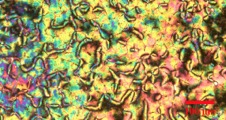Shakhawan Al-Zangana, featured ILCC liquid crystal artist, February 2016

He is working on the nano- and micro particles-liquid crystal suspensions under the supervision of Dr. Ingo Dierking and professor Michael Turner. The self-organization of various particles, such as spherical ferroelectric nanoparticles and two-dimensional graphene oxide microparticles in the nematic and smectic liquid crystal phases are the primary focuses of his research. Different ligands are employed for the surface modification of the particles for making stable suspensions. More attentions are paid toward the effects of these functional particles on many liquid crystalline properties such as phase transitions, dielectric anisotropy, Fréedericksz transition, elastic constants and the electro-optical response times. The aims are to improve the performance of the liquid crystal materials, and investigate the self-assembling and self-organization of the nanoparticles in the liquid crystal matrix.
The study is carried out by utilizing several experimental techniques including Polarizing Optical Microscopy (POM) and electro-optic measurements, Dielectric Spectroscopy, Differential Scanning Calorimetry (DSC), Fourier Transform Infrared Spectroscopy (FTIR).
Email: Shakhawan.al-zangana@hotmail.com

The image was taken with a Leica polarizing microscope (DML) equipped with a green objective of 20X amplification. The long side length of the photograph is approximately 768µm in length.
